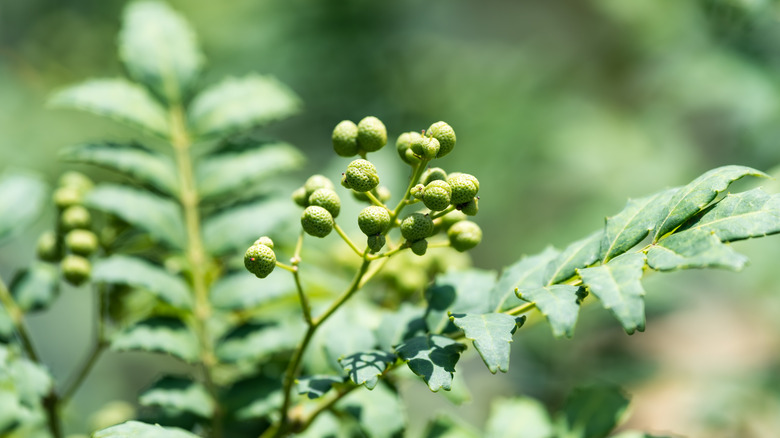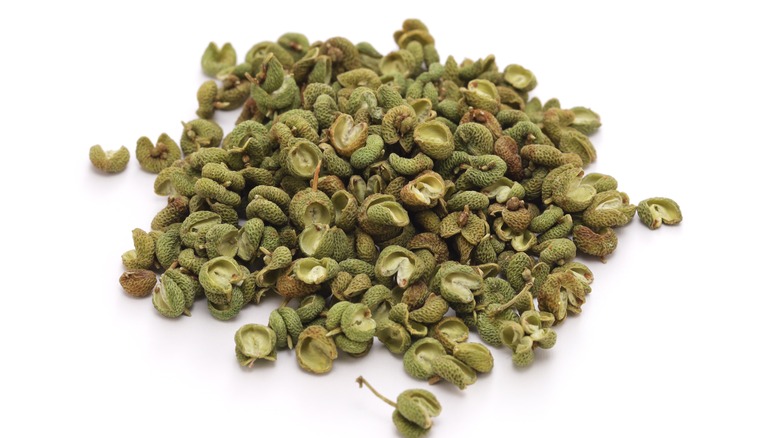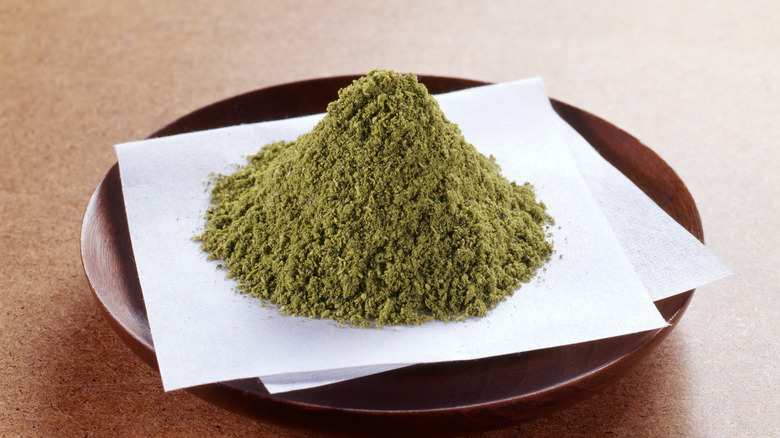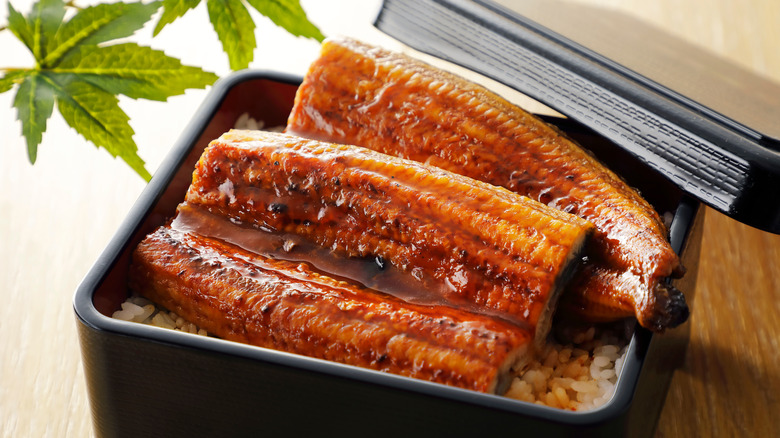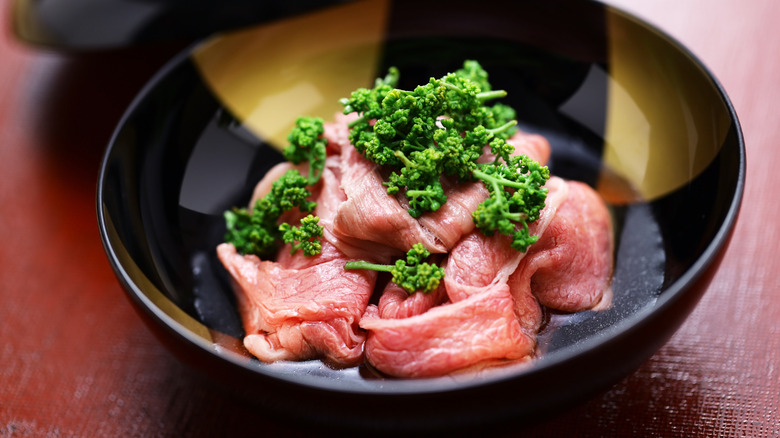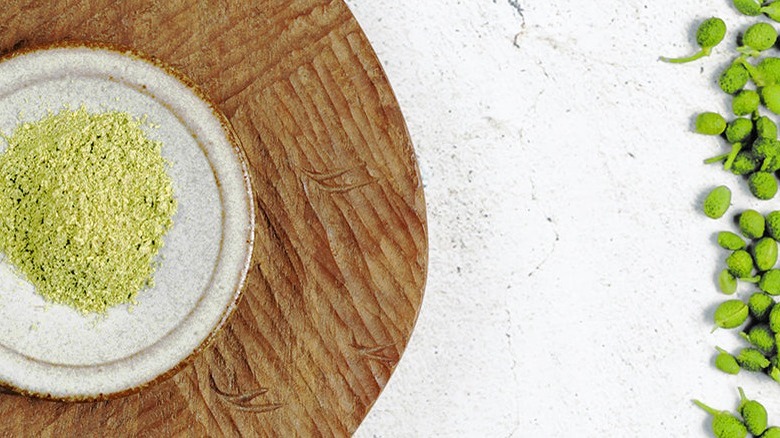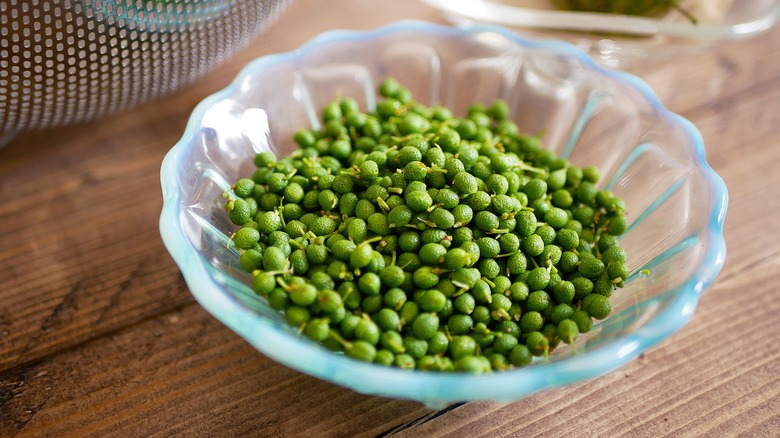Sansho Peppercorn, The Tingly Seasoning For Big Citrus Flavor
Your tongue may be familiar with the Chinese Sichuan peppercorn, a distinctive spice that makes the tongue tingle with a numbing effect, used heavily in popular dishes like dry pot, mapo tofu, and dan dan noodles. But there's another cousin to this popular peppercorn that also deserves attention: The Sansho peppercorn, a Japanese variety of Sichuan peppercorn that is much more powerful than its Chinese cousin when it comes to a tingling numbing sensation. In Japanese, the name for this green peppercorn is kona-zanshō , which is used in Japan in cooking as liberally as black peppercorn is used in the West. It's a versatile spice that can be used in everything from savory dishes to desserts and cocktail infusions.
Sansho peppercorn is often used with eel dishes in Japanese cuisine, but this citrusy spice is an underrated flavor and sensation bomb that deserves much more recognition. Here's everything you need to know about the Japanese sansho peppercorn (zanthoxylum piperitum).
What is sansho peppercorn?
Sansho peppercorn grows on a shrub-like tree, which has small twigs that give way to oval leaves and green flowers that make an appearance in June. The flowers then bear small, reddish capsules that contain the prized black seeds, or the sansho peppercorn. These Prickly Ash trees are native to Northern China, Korea, and Japan, and the traces of the peppercorn found indicate its usage as early as the Jomon period in Japan and written records of the peppercorn usage exist from the 3rd century in China.
The fruits of the sansho tree look like green grape bunches that turn red and pink when mature, but they are harvested before maturation. At around a size of 3-5 millimeters in diameter, the lime green fruit is prized for its aromatic, prickly, and sharp taste which also has a citrus flavor with notes of lemon, citronella, yuzu, and mint. These tiny but powerful berries are usually dried for concentrated flavor punch in culinary usage.
History of sansho peppercorn
Parts of the Sansho tree like the leaves and fruits have long been used for medicinal purposes before being used for culinary pleasure; During the Heian era of Japan, sansho pepper, then known as naruhajiki, was used to treat diarrhea. A bit later, as early as the 12th century, evidence shows samurai used the sansho spice while hunting in the time of the Kamakura era. Around this time was also when sansho peppercorn began to be commonly used on eel dishes, a practice that has endured today, as some sansho pepper is sold explicitly for that purpose.
However, it wasn't until the 19th and 20th centuries that humans began to cultivate Sansho on a larger scale, and today the Wakayama prefecture in Japan is the world's largest producer of the citrusy spice, of the budo (grape) sansho peppercorn variety. There, the peppercorn is harvested, dried, and ground as slowly as possible in order to preserve its unique flavor.
What does sansho peppercorn taste like?
Sansho peppercorn has a refreshing spiciness that has a citrusy taste that some liken to a citrus-based pepper with a spicy kick. The tingling sensation imparted by the sansho peppercorn is residual, meaning it'll continue to spark your taste buds even after you've swallowed the ground berry. It's a brighter and more citrusy version of Sichuan peppercorn.
Fresh sansho fruit immediately numbs the palate, but soon the citrus flavor takes center stage on your tongue and is good for cutting through rich, fatty flavors. Dried sansho peppercorn flavor is layered and complex; It may take about 15 seconds for all of the elements to reveal themselves on your tongue, from the woody citrus to hints of lemongrass to spicy pepper and even lemon and white pepper. A little of sansho peppercorn can go a long way, and there is even a Japanese saying that states, "Sansho has small grains, but still packs a peppery punch," which is a testament to its large flavor despite its tiny size.
How to cook with sansho peppercorn
Fresh sansho peppercorn may be hard to source out of Japan, but the fresh berry can be eaten straight, pickled, used in dips and spreads, infused into oils and liquors, as a preservative for meats and fish, and even simmered with soy sauce and sardines to make Chirimen sansho, which is also called Ojako, popular in Kyoto.
Dried and ground sansho peppercorn is more accessible and has been used for centuries in dishes like stews, soups, on sushi, and even as a spice rub for grilled meats. Sansho pepper is also one of the seven ingredients in the popular shichimi spice mix and is also used in O-toso, a type of sake infused with the peppercorn that's traditionally drunk on New Year's Day in Japan. Sansho peppercorn can be used liberally in cooking; You can sprinkle it on yakitori, in curries, hot pot, on ramen noodles, or even in a salad dressing for a subtle zing. Japanese locals will even use sansho in pound cakes, syrups for drinks, and for sansho-flavored ice cream with sansho sprinkled on top.
Where to buy sansho peppercorn
If you're headed to your local grocery store, first try an Asian supermarket in the spice aisle or in the fresh produce aisle — if you're lucky enough to find them fresh, know that they must be consumed, pickled, or dried since they only keep for a few days. Dried, sansho peppercorns keep best in a cool and dark place.
Dried sansho peppercorn is also easy enough to find for purchase online from various spice distributors, either ground or the whole sansho peppercorns themselves.
H Mart also carries the S&B brand of ground sansho pepper, though do note that the brand name has the spelling of sansyo. If you just want to get a small taste of sansho peppercorn, you can test out the Shichimi Togarashi spice blend which is easily findable on Amazon, or head to Trader Joe's, since they offer a spicy mochi snack that contains sansho peppercorn as an ingredient.
Nutritional information about sansho peppercorn
Beyond the distinctive and lingering taste of the bright and fiery sansho peppercorn, it also boasts a slew of health benefits. The sansho berry is filled with vitamin A, which protects eye health, vitamins B12, V9, and also packs a powerful calcium punch, which makes the seasoning good for the bones. Old Japanese encyclopedic texts state that "the berries eliminate colds, warm the body, make hair and teeth strong, brighten the eyes if taken for a long time, and improve one's complexion," per Budo Sansho, and in contemporary Japan, sansho is still used in the pharmaceutical industry.
Though there isn't much recent scientific research behind the medicinal uses of sansho peppercorn, it's been reported that the berry has been used to treat tuberculosis, asthma, and indigestion, and has been used as a diuretic. True to its nature of being small but mighty, one must not consume sansho peppercorn in excessive quantities, because in large doses the spice is toxic so eat sansho with caution.
